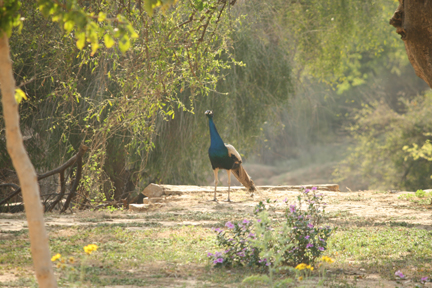Throughout the world, we see communities coming together to combat raging issues such as HIV, epidemics, violence, education, environment and so on. Voluntary actions by citizens have been vivacious and thriving for longer than the corresponding governmental initiatives. It is because of this unique understanding of historical, cultural and causal points, the former have a higher chance of success in fostering the community in a holistic manner. The projects of Grow-Trees are living examples of this theory where with the help of opportune funds and a multifaceted steering group, communities have managed to reforest their lands for multidimensional benefits to man and wild.
One such example is a Grow-Trees’ project at the periphery of Sariska Tiger Reserve at Alwar in Rajasthan. The areas adjoining the forest are rural and mainly consist of tribal population, mainly Bhil, Meena and Gujjar tribes.

The aforementioned areas known as “Orans”, or Devbani, in local parlance, are a spread of 1 lac hectare in Rajasthan and are common preserved sections of forests protected by villages and managed by communities after the name of local Gods and Goddesses. These Orans, over the years, have been deforested and so did the wealth of communities living the areas. Communities in Alwar recognise Orans as a source of water, food, fodder, fuel and medicines. They are often the only surviving areas of mature woodland in otherwise denuded surroundings and provide a refuge for wildlife.

There were multiple reasons for the degradation of Orans. Primary reason has been over-grazing and the transition in livestock rearing practices i.e. taming more goats than cows. From growing grass to bushes, there is a major change in vegetation composition because of increasing goat vendors, and other market related factors. Secondary reason for the same is the lack of proper demarcation of Orans because of which some lands were taken over by the forest department leaving the communities detached from their own lands leading them to over-extraction of resources.
Changing lifestyles had changed the medical practices in rural areas as well. At Orans, the old Saints who used to treat people and take care of the medicinal trees lost their value and hence people stopped caring about such trees. So, the medicinal plants especially those whose roots such as Chapun (Grewia hirsutae Vahl)- used for retention of placenta, or Jhad desi (Zyziphus mauritiana)- used for foot rot, declined sharply in number. These factors were multiplied by the lack of rainfall in the area. Where it used to be 600 mm of steady rainfall in the region a decade back, it is reduced to 400 mm irregular rainfall. For the grass to grow and the soil to draw the water to the water table, slow and steady rainfall is crucial. Consequently, the nature of soil has reduced from semi-arid to arid in last few years.
For the revival of Orans, KRAPAVIS, an NGO headed by Mr. Aman Singh, a biologist, had come forward two decades back and since then has done commendable work and has been rewarded umpteen times internationally. Grow-Trees tied up with KRAPAVIS (planting partner) in the year 2011 and since then it has funded the plantation of over 2 lac trees in the project.

The planting partner has brought together the communities and perform all activities that are imperative for the rejuvenation of the lands such as planting trees, setting up a seed bank, building and maintaining ponds, water harvesting, setting up village level institutions for better management and so on. Many local species which include fruit trees and medicinal plants as well have been reintroduced in the areas and people are encouraged for the upkeep of the same; a step that will help preserve the biodiversity of the area. With available funds, artificial water tanks have been also been built and maintained which are beneficial for nursery raising and also for local use.
Apart from planting trees at Grassroots level, policy makers are also approached for the revival of Orans who have agreed for the demarcation of the areas. Earlier, state government had leased out the lands but KRAPAVIS convinced them to do a proper survey and put the area under revenue land where it will be owned by the Tehsildar but will be maintained by the communities in the area. Under Rajasthan Forest Policy, it is proposed that a new legally accepted committee will be formed on the community/village level for the maintenance of Orans.
The plantation of 2 lac trees by Grow-Trees in the area has created almost 17,000 workdays of jobs in these areas mainly in the nursery raising and planting activities. Major beneficiaries are rural women who earn an additional source of income from these activities. Grown up trees are already providing the communities with various resources. They are providing natural habitats to wildlife as well as animals such as peacocks can be seen in abundance in many areas which were earlier deserted of the same. Having managed to reforest almost 200 acres of Oran lands, Grow-Trees is also helping to offset hundreds of tons of Carbon dioxide each year by this project alone thereby also cleaning the atmosphere.

The traditional top down approach for environment protection and poverty alleviation will take a long time and more resources. Interestingly, Grow-Trees has an easy way to do it. It is channelling the finances for the community by the community i.e. Grow-Trees users. Thousands of individuals have planted trees at the Grow-Trees’ website i.e. www.grow-trees.com and dedicated these trees to their loved ones to greet or to pay tribute; sometimes just to offset their carbon emissions. Hundreds of companies have used the website to plant trees for their stakeholders. The beautiful eTreeCertificates that are generated from the website are helping people to use the idea to move away from conventional greeting cards.
One party getting a way to greet and other getting livelihood, call it a win-win, won’t you?